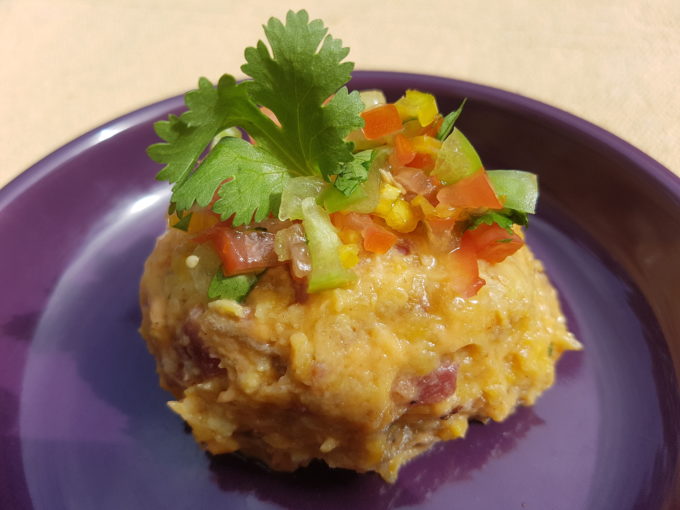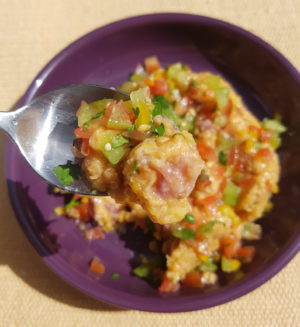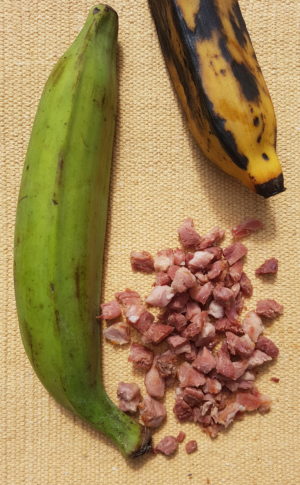
Tacacho con Cecina y Aji de Cocona (knock-off)

This is an example of a dish in which The Whole adds up to more than the sum of it’s parts. The sweet plantains pair incredibly with the salted pork, while the tangy and hot relish rounds everything out.
This mashed plantain dish hails from Peru. Amazonian Peru. This is a relatively important note, as different parts of Peru produce different staple foods. For instance, in the mountainous Andes regions (Sierra) you are more likely to see crop based dishes with potatoes or quinoa, and slow roasted meats, commonly guinea pig. Along the coastline, (Costa) for obvious reasons, there is a major focus on seafood, along with many starch choices. The Amazonian regions, (Selva) in turn, focus on the fish of the river, turtles and caymans, and the many fruits the jungle has to offer. Here, the banana is King Starch. This region is also home to the wild peccary, AKA javelina or scunk pig. Although it sure resembles a pig it is not actually a true pig. It is, however, no doubt where the common use of salted pork, concina, comes from. The amazon jungle has hosted some of the longest lasting traditionally living peoples in the world. This surely means fire roasted meat, and the use of salt for curing, aging, and preserving. Though now commonly made from the European pig, the re-hydrated salted pork of Peru is not only a pride of the country, but a must have for visitors.
The traditional life of the selva cultures can easily be seen through tacacho con cecina. Unlike many of the other plantain breakfasts I’ve been enjoying as of late, the plantains here are roasted (or fried) in pork fat; reminiscent of open fire cooking. Then, served either mixed in or on the side, is the cecina, the before mentioned, re-hydrated, salt cured pork.

As for the finishing touch for this dish, what is one thing every part of Peru has in common? CHILIES! Known locally as ‘aji,’ amarillo, rocoto, panca, limo, charapita, and mirasol are the the top contending chilies. Our other special ingredient is a fruit found only in the Amazon, cocona, and it’s unlike anything else on earth, or so it seems if you are trying to replicate the flavor. It has been described as tasting like a tangy tomato that has, perhaps, been crossed with a lime. Put these two main ingredients together and you get aji de cocona; Cocona and Charapita Chili Sauce/Relish.
I will unabashedly acknowledge that I do not have access to either cocona or aji charapita at this moment, but the idea is so intriguing to me that I have decided to make a knock-off version. If you live near a good Latin American market, I encourage you to make the real-deal of this simple topping, by combining chopped cocona and aji charapita, with some salt and fresh cilantro. If that isn’t an option, feel free to try the recipe below, as both a way to boost this breakfast, and as a useful addition for many other dishes! After all, who doesn’t like a new hot sauce recipe?
Tacacho con Cecina y Aji de Cocona (knock-off)
Roasted Plantains with Pork and Citrus Chili Relish
By: Semiserious Chefs
Serves: 3-4
Ingredients:
- 2 large yellow plantains; peeled and halved lengthwise
- 8 ounces of salted pork re-hydrated; cubed
- OR bacon or ham; diced
- OR bacon or ham; diced
- Aji de Cocona Knock-Off:*
- 2 vine/roma tomatoes; finely minced
- 1 tomatillo; finely minced
- 1/2 of a serrano chili; finely minced
- 1 t lime juice
- 1/4 t sea salt
- Optional: 1/2 bunch cilatro; finely chopped
*NOTES: Yellow colored tomatoes and chilies will make this relish look a little more authentic. You can also bulk this out by adding minced red onions.
Directions:
- Fry the bacon or ham, and reserve the fat.
- Using the fat from the meat in step one, or a tablespoon of pork fat, fry/roast the plantains on all sides, over medium heat, until golden and soft.
- Mash the plantains in a large bowl, until smooth. Add some water as needed.
- Add the chopped bits of pork and roll the tecacho into neat balls for each plate.
- Serve with Aji de Cocona as desired.

Post a comment